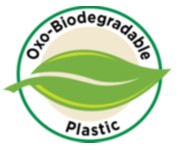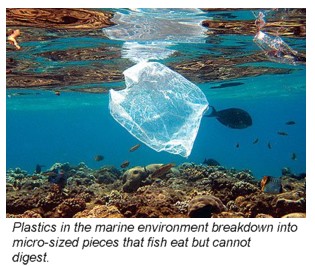The Future of Plastics - Is there a solution?
 Plastic - it has become the cornerstone of our modern life style, and one of the most challenging global waste management problems.
Plastic - it has become the cornerstone of our modern life style, and one of the most challenging global waste management problems.So beneficial in countless ways, this nearly indestructible material is littering our environment on land and sea. Difficult to recycle, as post-consumer waste, and hard to break down, plastic in its many forms has become a serious environment problem.
But solutions may be in sight.
Much research is underway around the world to develop plastics that are degradable and have much lower environmental impacts. One stream of research focuses on bio-plastics, plastic compounds derived largely from biomass sources, mixed with oil-based materials in some cases.
A more recent line of inquiry focuses on oxo-biodegradable plastics (oxo-bios)
Advantages of oxo-biodegradable plastic
The outstanding ecological advantage of oxo-bio is its controlled lifespan and the ability to degrade completely and automatically in aerobic conditions even if not collected, and without leaving any residues, Oxygen is required for complete degradation, which can occur on land or water.
Oxo-bio plastics are made of naphtha, a waste product of oil refining which used to be burnt off into the atmosphere as an added pollutant.
 No extra oil has to be refined for the production of oxo-bios, therefore avoiding additional pollution and oil-depletion.
No extra oil has to be refined for the production of oxo-bios, therefore avoiding additional pollution and oil-depletion.Compared to bio-plastic, using oxo-bios for plastic packaging is cheaper and less carbon is used in its manufacture.
Although the first priority is to solve the problem of plastic which gets abandoned into the environment and cannot realistically be collected for disposal, oxo-bios are compostable in appropriate facilities designed to the latest EU standards.
While bio-plastics will contaminate existing recycling systems when being mixed with conventional plastic for recycling, oxo-bios won’t do any harm.
Production of oxo-bios
The oxo-biodegradable additive changes the molecular structure of the conventional plastic, making it oxo-biodegradable. As the additive is fed into the plastic during the extrusion stage in the manufacture, there is no need to retool or to extensively alter the existing manufacturing system.
A transition metal salt in the additive works as a catalyst but might lead to premature degradation when exposed to heat. Thus, special stabilizers that protect the catalyst during processing but allow degradation at the end of the product’s useful life have to be included in the additive formulation.
Special balancing skill is required as these stabilizers have to be appropriate for the processing temperatures and raw material specifications, but also suitable for the envisaged shelf life of the finished product.
Oxo-Biodegradation
Oxidation is the initial degradation process. It reduces its molecular weight to sub 40,000 Daltons so that the material ceases to be a plastic and is as biodegradable as a leaf.
The residues convert into non-toxic substances such as carboxylic acids, aldehydes and ketones that grow ever smaller and don’t harm the environment. The metal salts in the additives are trace elements, necessary for healthy plant and animal life, and there are no “heavy metals.”
If buried in a landfill, oxo-bios still degrade as long as oxygen is available. Without oxygen, oxo-bios are inactive - without emitting methane, in contrast to other degradable plastics.
Technical and safety standards
To be categorized as an oxo-biodegradable plastic, the product has to meet the American Standard D6954 or the British Standard BS 8472 for the oxo-biodegradability of plastic litter in the environment. Additionally, eco-toxicity tests in EN 13432 and ASTM D6954 confirm that it does not release toxic residues, and EU and US requirements for direct contact with food have to be met as well.
“If the plastic waste now floating in the Pacific - the so-called Pacific Garbage Patch - had been made of oxo-biodegradable plastic, most of it would have degraded by now and there would be no ‘garbage patch’.” Professor Gerald Scott, Chief Scientific Adviser to the Oxo-Biodegradable Plastics Association
Prove of effectiveness
The competition with bio-plastics, subjective reports and disinformation put much pressure on the image of oxo-bios, which several studies and reports tried to set aright by supporting its use.
In February 2011, the UK Environment Agency published a Lifecycle Assessment (LCA) report, showing that ordinary and oxo-bio plastic bags had a better LCA than paper or compostable (bio-based plastic) bags.
As well, a scientific dossier, proving the biodegradability, non eco-toxicity, and recyclability of oxo-bios was submitted by the British Plastics Federation to the UK Government in 2011.
The increasing supply of information about the ecological benefits of oxo-bios has already led to a greater interest in the products.
In particular, developing countries, where the large amounts of plastic waste on beaches, in rivers, in forests, and in oceans are impossible to collect effectively, have increased their use of oxo-bios and some have already legislated to make it mandatory.
Oxo-bios have a chance to become the plastic of the future, especially if experts continue improving their image and emphasizing their outstanding advantages - the controlled lifespan and complete biodegradation without leaving toxic residues - which might be of great value in the global fight against the huge plastic waste management problem.
You can return to the main Market News page, or press the Back button on your browser.

